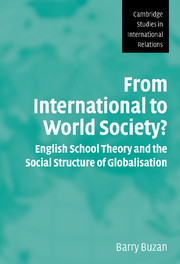 From International to World Society?
From International to World Society? Published online by Cambridge University Press: 14 January 2010
The debate about pluralism and solidarism leads into the question of the institutions of international society. It seems safe to say that there will be a close relationship between where an international society is located on the pluralist–solidarist spectrum, and either what type of institutions it has, or how it interprets any given institution. A number of authors have, for example, tracked the evolution of sovereignty, relating it, inter alia, to changes in the internal character of the dominant states (Keohane 1995; Reus-Smit 1997; Barkin 1998; Sørensen 1999). The concept of institutions is central to English school thinking for three reasons: first, because it fleshes out the substantive content of international society; second, because it underpins what English school writers mean by ‘order’ in international relations; and third, because the particular understanding of institutions in English school thinking is one of the main things that differentiates it from the mainstream, rationalist, neoliberal institutionalist, study of international regimes. Quite a bit has been written about the similarities and differences between the English school approach to institutions and that of regime theory (Keohane 1988; Hurrell 1991; Evans and Wilson 1992; Buzan 1993; Wæver 1998: 109–12; Alderson and Hurrell 2000). There is general agreement that these two bodies of literature overlap at several points, and that there is significant complementarity between them. The essential differences are:
(1) regime theory is more focused on contemporary events while the English school has a mainly historical perspective;
[…]
To save this book to your Kindle, first ensure [email protected] is added to your Approved Personal Document E-mail List under your Personal Document Settings on the Manage Your Content and Devices page of your Amazon account. Then enter the ‘name’ part of your Kindle email address below. Find out more about saving to your Kindle.
Note you can select to save to either the @free.kindle.com or @kindle.com variations. ‘@free.kindle.com’ emails are free but can only be saved to your device when it is connected to wi-fi. ‘@kindle.com’ emails can be delivered even when you are not connected to wi-fi, but note that service fees apply.
Find out more about the Kindle Personal Document Service.
To save content items to your account, please confirm that you agree to abide by our usage policies. If this is the first time you use this feature, you will be asked to authorise Cambridge Core to connect with your account. Find out more about saving content to Dropbox.
To save content items to your account, please confirm that you agree to abide by our usage policies. If this is the first time you use this feature, you will be asked to authorise Cambridge Core to connect with your account. Find out more about saving content to Google Drive.